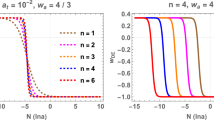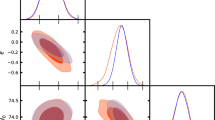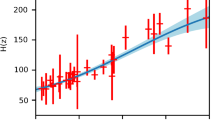Abstract
The nature of the dark energy is still a mystery and several models have been proposed to explain it. Here we consider a phenomenological model for dark energy decay into photons and particles as proposed by Lima (Phys Rev D 54:2571, 1996). He studied the thermodynamic aspects of decaying dark energy models in particular in the case of a continuous photon creation and/or disruption. Following his approach, we derive a temperature redshift relation for the cosmic microwave background (CMB) which depends on the effective equation of state w eff and on the “adiabatic index” γ. Comparing our relation with the data on the CMB temperature as a function of the redshift obtained from Sunyaev–Zel’dovich observations and at higher redshift from quasar absorption line spectra, we find w eff = −0.97 ± 0.03, adopting for the adiabatic index γ = 4/3, in good agreement with current estimates and still compatible with w eff = −1, implying that the dark energy content being constant in time.
Similar content being viewed by others
References
Lima J.A.S.: Phys. Rev. D. 54, 2571 (1996)
Perlmutter S. et al.: Astrophys. J. 517, 565 (1999)
Reiss A.G. et al.: Astron. J. 116, 1009 (1998)
de Bernardis P. et al.: Nature 404, 955 (2000)
Spergel D.N. et al.: Astrophys. J. Suppl. 170, 377 (2007)
Caldwell R., Kamionkowski M.: Ann. Rev. Nucl. Part. Sci. 59, 397 (2009)
Peebles P.J.E., Rathra B.: Rev. Mod. Phys. 75, 559 (2003)
Padmanabhan T.: Phys. Rep. 380, 235 (2003)
Demianski M., Piedipalumbo E., Rubano C., Tortora C.: Astron. Astrophys. 431, 27D (2005)
Cardone V.F., Tortora C., Troisi A., Capozziello S.: Phys. Rev. D 73, 043508 (2006)
Caldwell R.R.: Phys. Lett. B 545, 23 (2002)
Peebles P.J.E., Ratra B.: Astrophys. J. Lett. 325, L17 (1988)
Ratra B., Peebles P.J.E.: Phys. Rev. D 37, 3406 (1988)
Sahni V., Starobinsky A.A.: Int. J. Mod. Phys. D 9, 373 (2000)
Ma Y.: Nucl. Phys. B 804, 262 (2008)
Lima J.A.S., Silva A.I., Viegas S.M.: Mon. Not. R. Astron. Soc. 312, 747 (2000)
Lima J.A.S., Alcaniz J.S.: Astron. Astrophys. 348, 1 (1999)
Puy D.: Astron. Astrophys. 422, 1 (2004)
Ge J., Bechtold J., Black J.: Astrophys. J. 474, 67 (1997)
Srianand R., Petijean P., Ledoux C.: Nature 408, 931 (2000)
Molaro P., Levshakov S., Dessauges-Zavadsky M., D’Odorico S.: Astron. Astrophys. 381, L64 (2002)
Puy D., Alecian G., Leorat J., Lebourlot J., Pineaudes Forets G.: Astron. Astrophys. 267, 337 (1993)
Galli D., Palla F.: Astron. Astrophys. 335, 403 (1998)
Stancil P., Lepp S., Dalgarno A.: Astrophys. J. 509, 1 (1998)
Cui J., Bechtold J., Ge J., Meyer D.: Astrophys. J. 633, 649 (2005)
Srianand R., Noterdaeme P., Ledoux C., Petijean P.: Astron. Astrophys. 482, L39 (2008)
Sunyaev R., Zel’dovich Y.: Comments. Astrophys. Space. Phys. 4, 173 (1972)
Fabbri R., Melchiorri F., Natale V.: Astrophys. Space. Sci. 59, 223 (1978)
Luzzi G., Shimon M., Lamagna L., Rephaeli Y., De Petris M., Conte A., De Gregori S., Battistelli E.: Astrophys. J. 705, 1122 (2009)
Mather J.C. et al.: Astrophys. J. 512, 511 (1999)
Komatsu E. et al.: Astrophys. J. Suppl. 180, 330 (2009)
Daly R.A. et al.: Astrophys. J. 677, 1 (2008)
Kowalski M. et al.: Astrophys. J. 686, 749 (2008)
Kessler R. et al.: Astrophys. J. Supp. 185, 32 (2009)
Author information
Authors and Affiliations
Corresponding author
Rights and permissions
About this article
Cite this article
Jetzer, P., Puy, D., Signore, M. et al. Limits on decaying dark energy density models from the CMB temperature–redshift relation. Gen Relativ Gravit 43, 1083–1093 (2011). https://doi.org/10.1007/s10714-010-1091-4
Received:
Accepted:
Published:
Issue Date:
DOI: https://doi.org/10.1007/s10714-010-1091-4




